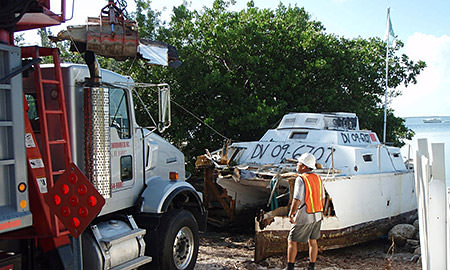Marine Debris
Florida Keys

Why is it a concern?
Increasing levels of debris in both the ocean and at the land-sea interface are of growing concern to stakeholders of the Florida Keys National Marine Sanctuary (FKNMS). Marine debris in the form of derelict fishing gear can destroy benthic organisms, entangle both benthic and mobile fauna, and reduce the structural complexity of habitats. Currents associated with strong storms can move debris onto reefs, where corals and other benthic organisms are damaged or killed. In 2005, it was estimated that approximately 300,000 lobster traps were lost during a series of hurricanes and strong storms. The ecological impacts caused by hook-and-line fishing gear that is lost when cut or broken after snagging on the bottom is also a growing concern to managers and stakeholders.
Surveys of marine debris in the sanctuary have found that types causing the greatest degree of abrasion damage to sessile invertebrates such as sponges and corals were hook-and-line gear (68%), especially monofilament line (58%), followed by debris from lobster traps (26%), especially rope (21%). A concerted effort to document the spatial extent, amount, and impacts of marine debris in 2008 indicated derelict angling and trap gear is ubiquitous in the sanctuary, even within no-take zones. The sheer amount of debris recovered annually is testament to an increasingly visited and exploited marine ecosystem.
Overview of Research
Research conducted by Sanctuary scientists and partners provides critical information to address existing and emerging resource conservation and management issues. The Overview of Research highlights some, but not necessarily all, of the research activities completed or ongoing at the Sanctuary.
| Project Name | PI and contacts | Links |
|---|---|---|
Rapid assessment and monitoring of coral reef habitats in the Florida Keys National Marine Sanctuary |
Steven Miller, Mark Chiappone, Leanne Rutten – NOVA Southeastern University |
|
Removal of Marine Debris used as Lobster Aggregating Structures (Casitas) |
NOAA Fisheries and FKNMS |
|
Shoreline clean ups - removal of marine debris from shorelines and mangroves. |
NOAA FKNMS Team OCEAN |
http://floridakeys.noaa.gov/volunteer_opportunities/teamocean.html http://floridakeys.noaa.gov/scisummaries/marinedebris2013.pdf |
Removal of abandoned/derelict vessels and marine debris |
FKNMS, Monroe County, FWC, USCG, NOAA Fisheries, FDEP |
Science Needs and Questions
The best available science is used by Sanctuary scientists and managers working to address priority resource conservation and management issues. As priorities change and new issues emerge, each Sanctuary develops new science needs and questions and works with partners to address them.
- What are the accumulation rates of marine debris within the sanctuary?
- Are certain areas of the sanctuary more or less susceptible to marine debris accumulation and/or impacts?
- Are there critical habitat areas that should be prioritized for marine debris removal efforts?
Education and Outreach Material
Marine Debris in Reef Habitats, Florida Keys NMS One Pager
NOAA Marine Debris Program Education Materials
References
Chiappone, M., A. White, D.W. Swanson, S.L. Miller. 2002. Occurrence and biological impacts of fishing gear and other marine debris in the Florida Keys. Marine Pollution Bulletin 44(7):597-604.
Chiappone, M., H. Dienes, D.W. Swanson, S.L. Miller. 2004. Spatial distribution of lost fishing gear on fished and protected reefs in the Florida Keys National Marine Sanctuary. Caribbean Journal of Science 40(3) 312-326.
Chiappone, M., H. Dienes, D.W. Swanson, S.L. Miller. 2005. Impacts of lost fishing gear on coral reef sessile invertebrates in the Florida Keys National Marine Sanctuary. Biological Conservation 121(2):221-230.
Clark, C. 2006. Lobster fishermen stake it all on 2006 season. Miami Herald. Miami, FL.
Derraik, J.G. 2002. The pollution of the marine environment by plastic debris: a review. Marine Pollution Bulletin 44(9):842-852.
Donohue, M., R. Boland, C. Sramek, G. Antonelis. 2001. Derelict fishing gear in the northwestern Hawaiian Islands: diving surveys and debris removal in 1999 confirm threat to coral reef ecosystems. Marine Pollution Bulletin 42:1301–1312.
Gittings, S.R., M. Tartt, and K. Broughton. 2013. National Marine Sanctuary System Condition Report 2013. U.S. Department of Commerce, National Oceanic and Atmospheric Administration, Office of National Marine Sanctuaries, Silver Spring, MD. 33 pp.
Miller S.L., M. Chiappone, L.M. Rutten. 2008. Large-scale assessment of marine debris and benthic coral reef organisms in the Florida Keys National Marine Sanctuary – 2008 Quick look report and data summary. Center for Marine Science, Univ. North Carolina-Wilmington, Key Largo, FL. 271pp.
Miller, S.L., M. Chiappone, L.M. Rutten. 2010. Abundance, distribution, and condition of benthic coral reef organisms in the upper Florida Keys National Marine Sanctuary – 2010 Quick look report and data summary. Center for Marine Science, Univ. North Carolina-Wilmington, Key Largo, FL. 242pp.
NOAA (National Oceanic and Atmospheric Administration). 2008. Marine Debris Emergency Response Planning in the North-Central Gulf of Mexico Interim Draft Report. 44pp.
ONMS (Office of National Marine Sanctuaries). 2011. Florida Keys National Marine Sanctuary Condition Report 2011. U.S. Department of Commerce, National Oceanic and Atmospheric Administration, Office of National Marine Sanctuaries, Silver Spring, MD. 105 pp.
Sheridan, P., R. Hill, G. Matthews, R. Appeldoorn, B. Kojis, T. Matthews. 2005. Does trap fishing impact coral reef ecosystems? An update. pp. 511-519. In: Proceedings of the 56th Gulf and Caribbean Fisheries Institute. Tortola, British Virgin Islands. 851pp.
U.S. Dept. of Commerce and U. S. Navy. 1999. Turning to the Sea: America’s Ocean Future. 56 pp.

